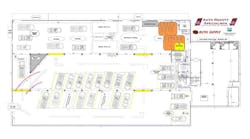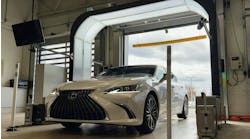What you'll learn:
- The prevalence of ICE vs. EVs
- New training requirements needed
- The need for a focus on safety and basic electrical fundamentals
The shortage of transportation technicians available to fill open industry positions has been well documented in the past few years. More recently however, an additional factor has entered the equation, that being the degree to which the entry of electric vehicles (EVs), autonomous vehicles and other bleeding-edge technology into the market will impact the technician demand.
The question arises as to whether the unfilled demand that we see now will continue into the future, in a world where it is clear that electric vehicles and potentially other zero-emission power plants are the wave of the future.
When examining the future technician shortage question, there are many factors that need to be considered. One of the most important facts we must be aware of is that the entry of this new technology will take place gradually over many years. The internal combustion engine (ICE) has had a long and very successful history in passenger vehicles, and it will not be replaced by electric power overnight. To put it into perspective, it is forecast that by 2030, battery electric vehicles (BEVs) will still only comprise 25 percent to 30 percent of new light vehicles sold annually.1
Another key factor to consider is the huge number of ICE vehicles already in operation in the market. The quantity of those existing vehicles dwarfs the number of new vehicles coming onboard each year. It is projected that nearly 290 million vehicles will be in operation on the roads and highways of America by the end of 2021. By comparison, looking ahead to 2030, even assuming sales of BEVs reach 30 percent of new light vehicles sold, that number will only be approximately 6.2 million vehicles.
Additionally, in evaluating the future technician shortage, it should also be remembered that the reality is that just because a vehicle is electric-powered does not mean that the need for all maintenance and repair suddenly goes away. It is true that electric vehicles require less service. The largest study to quantify these savings was recently released by the U.S. Department of Energy, Vehicle Technologies Office. That study evaluated vehicle maintenance costs for the General Services Administration U.S. government fleet, the largest fleet in the world. Detailed analysis showed that BEVs had a reduced maintenance cost of about 40 percent when compared to conventional ICE vehicles.2
But, is the reduced demand for technician hours for these vehicles significant? Yes, it might be when looked at in isolation, however, with the relatively small number of electric vehicles that are projected to be in use in relation to the overall vehicle population, we are talking about a gradual change over many years.
This being the case, a concern for both new entry-level technicians and current working technicians is how this changeover to electric vehicles and the introduction of other new technologies will affect the knowledge and skills they will need as technicians. The good news is that manufacturers as well as many schools offering technical training programs recognized this need early on, and have worked aggressively to develop and implement related curricula. For passenger vehicles, this first began with the introduction of Hybrid Electric Vehicles.
High voltage electrical systems entered the picture, and understanding how to safely disable and work on these systems became the #1 training priority to prevent serious injury or even death through electrocution.
New training courses moved on to an array of other subjects including battery technologies, power inverter systems, regenerative braking systems and motor and motor drive systems just to name a very few. However, Electric Vehicles by definition are a broad category, and within that sphere there are four sub-types: Battery Electric Vehicles (BEV), Hybrid Electric Vehicles (HEV), Plug-In Hybrid Electric Vehicles (PHEV), and Fuel-Cell Electric Vehicles (FCEV). As one might expect, due to different systems within these sub-types you will find training topics specific to each.
The last sub-type mentioned, Fuel-Cell Electric Vehicles (FCEV) are arriving later to market than the other EV types, and certainly in much smaller quantities. But they are expected to have a bright future down the road. Training for these vehicles will differ from all other EVs, as hydrogen is used as the fuel, bringing the understanding of fuel-cell technology, hydrogen storage system safety and refueling procedures to the table.
Natural gas-powered vehicles (NGV) continue to grow in popularity as another clean, cost-efficient alternative, both with Compressed Natural Gas (CNG) and Liquified Natural Gas (LNG). These systems are primarily found on commercial vehicles, particularly with refuse, transit and heavy-duty fleets. Some key training topics for these vehicles are safety procedures in working with natural gas, fuel system testing and inspection, and learning diagnostic skills specific to natural gas.
So, when it comes to looking at the knowledge and skills needed for the future as a transportation technician, there are two key topics that stand out.
The first priority must be on safety. Safety is always No.1, and most of these new technologies come with very specific requirements that need to be understood and followed, with severe repercussions for those that fail to do so. You can expect that there will be a heavy emphasis on that topic in related training courses.
The second key consideration is not a new one by any means. But with advancing technology and the complexities of new systems, its importance is growing. That topic is the understanding of electrical and electronics fundamentals. Whether you are speaking with management at OEMs, dealerships or independent service providers, there is unqualified agreement that the biggest shortfall in knowledge and skills we face as an industry is an in-depth understanding of electric and electronic fundamentals, both in theory and application. You can expect that the complexity of vehicle electrical systems will only continue to multiply exponentially in the future.
It is clear that with the shortage of technicians we are currently facing, and the number of new entry-level technicians entering the workforce every year, we are still going to be facing a shortage even as alternative fuel vehicles gradually enter the mainstream and eventually replace the internal combustion engine. The bottom line is, new technicians entering the transportation workforce can be assured of job security for many years to come. Proper training and the development of new knowledge and skills for new technician entrants, as well as for technicians already in the workplace will ensure they are prepared for the challenges and rewards of their future transportation technical career.



